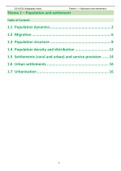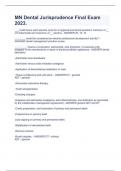CIE IGCSE Geography notes Theme 1 – Population and settlement
Theme 1 – Population and settlement
Table of Content
1.1 Population dynamics ........................................................ 2
1.2 Migration ......................................................................... 6
1.3 Population structure ........................................................ 8
1.4 Population density and distribution ............................... 12
1.5 Settlements (rural and urban) and service provision ...... 14
1.6 Urban settlements ......................................................... 16
1.7 Urbanisation .................................................................. 16
1
, CIE IGCSE Geography notes Theme 1 – Population and settlement
1.1 Population dynamics
Birth rate - no of ppl born per 1000 in a pop per year
Death rate - no of ppl died per 1000 in a pop per year
Natural population change - difference between birth rate & death rate
Overall population change - difference between BR & DR +/- for migration
Fertility rate - average number of children a female is expected to have in their lifetime
Life expectancy - no of years on average that a person is expected to live within a country
Infant mortality rate - no of deaths of children under the age of 1 per 1000 live births per year
Demographic Transition Model
Over-population - too many ppl living in an area for resources & space available
Under-population - not enough ppl living in an area so resources & space are wasted
Optimum population - level of pop is enough to fully use resources available, total pop at which GDP is at the
highest level
Why countries become over-populated (3)
• High population growth
• High birth rate due to lack of family planning
• Low death rate due to good healthcare services
• Large amount of immigration
Describe problems of over-population on a country. (4)
• There will a lack of sufficient resources to meet the needs of its population, which leads to lower standards
of living and increase number of people living in poverty.
• Also, the government does not have sufficient money to invest in public services eg education and
healthcare, leading to a poor quality of services and facilities.
• Moreover, diseases can spread easily in overcrowded living conditions and with insufficient medical services,
the life expectancy is reduced.
• Furthermore, traffic congestion occurs leading to atmospheric pollution from combustion.
• Additionally, deforestation occurs for building infrastructure or fuel wood to generate electricity to meet the
demand of its population
2
, CIE IGCSE Geography notes Theme 1 – Population and settlement
Describe problems of under-population (4)
• One of the problems caused by under-population is shortage of workers lead to lower optimum productivity,
which limits the countries' GDP.
• Also, resources are not able to be fully exploited eg outback is undeveloped and unused.
• Moreover, it is difficult to defend the country due to the lack of people in the defence force.
• Besides, government lacks financial resources to invest in public services due to the lack of tax collected. This
causes closure to public services eg schools and hospitals as they cannot meet the threshold population,
consequently, reduce the accessibility to public services.
Explain why countries with large areas of land may not be under-populated (5)
• High population density
• Large areas of land could be of little use eg deserts
• Few resources might be available eg coal
• High level of technology allows economy to develop without much labour, so all resources can be easily
exploited be few ppl
Explain why some areas are underpopulated. (3)
• Relatively few ppl living there coz of eg extreme climate
• Large amounts, surplus of resources
Suggest why child mortality is high in some countries in Africa (4)
• Poor healthcare, lack doctors, lack vaccination, lack medicine
• Poor food & water supply, hygiene, waterborne disease eg chlorea
• Poor education about diet
Suggest why countries with high child mortality have high birth rate (5)
• Ppl have lots of children to replace those that die at a young age
• Need children to help on land, in home to look after siblings and parents in old age, collect water, work to
earn money
• No state pensions for elderly so need to rely on children
Explain how gov policies influence pop growth rate (5)
• Anti-natalist policy
• Restrict family size by limiting no of children
• Education ppl about contraception
• Make birth control or contraceptives more afforable
• Educate women to encourage them to take jobs
• Increase marriage age
HIV/AIDS
Origin Impact
• HIV-1 – arose in • HIV mostly occurs in women
Central Africa • When women give birth, they infect the child → ↑ death rate for infants
• HIV-2 – arose in • Death rate of mothers → ↑ orphans
West Africa • Due to countries being poor → lack of state welfare → poverty & lack of education
3
, CIE IGCSE Geography notes Theme 1 – Population and settlement
Case studies
High rate of natural population growth / Over-population - Bangladesh
Basic info Capital city - Dhaka
Neighboring countries - India & Myanmar
Population - 160 million
Population density - 1000ppl/km2
Growth rate - 1.2%
Causes for Birth rate: 18/1000 Death rate: 6/1000
high pop
growth • Lack of availability & knowledge of child cost Improvement in
& family planning • Health care → ↓
• Lack of access to contraceptives - 62% use child mortality
contraception, which increases the risk of • Education
unintended pregnancies and fertility rate • Clean water supply
• Most ppl are subsistence farmers → need • Food supply
many children as economic assets to help • Sanitation
them work on the farms
• Many women are uneducated, don't have a
job. They have a early marriage - 1/3 girls
married by 18 years old, women marrying
earlier tend to have children earlier & bear
more children over their lifetime
• No state pension → many children to take
care when they're old
• High infant mortality rate (30/1000 per year)
so ppl have lots of children to replace those
that die at a young age
Impacts • Shortage of job opportunities cause high unemployment. Consequently, 25% of the
population living below the poverty line of $1.25 per day.
• Lack of education, housing, health care provision, due to the lack of sufficient
resources to meet the needs of it’s the population, 13% of the population do not
have access to clean water, which cause more people to suffer from water borne
disease eg cholera. Also 33% of the children under 5 are underweight due to the
lack of food supply
• Life expectancy is reduced to 52 years old as overcrowding cause diseases to be
spread easily and lack of medical service
• Urban area → pollution from traffic congestion
• Over cultivation of land to grow crops to meet the demand of large pop reduces soil
fertility, which reduces crop yield & leads to malnutrition for many ppl
• Unemployment → low standard of living, GDP: US$380
Solutions • Anti-natalist policy (family planning / ↓ birth rate)
• Law-marriage age, women: 18, men: 21
• Support for full-time area health workers who provide contraception service
• Limit families to 2-3 children
• Improve women's education
• Success? - In 1981: 18%, 2015: 60%
• Obstacles - Many women governed by purdah → can't leave home without
permission
→ difficult for health workers to contact
4






